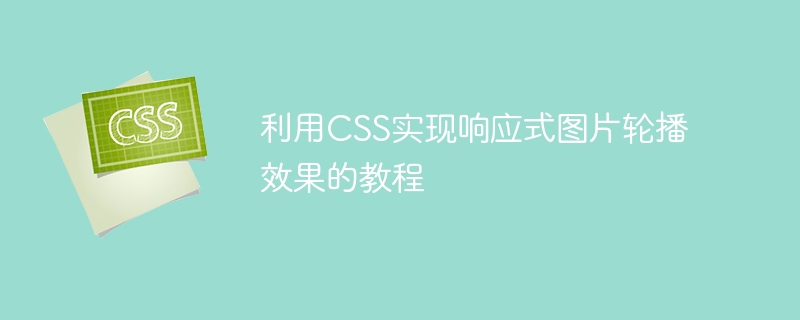

Tutorial on using CSS to achieve responsive image carousel effect
With the popularity of mobile devices and the advancement of technology, responsive website design has become one of today’s design trends. one. In the design process, image carousels are one of the common elements, which can effectively display information from multiple images to users.
This tutorial will share how to use CSS to achieve responsive image carousel effects and provide specific code examples.
Step 1: HTML structure
First, in the HTML file, we first create a container (div) to wrap the image and navigation buttons. Then, set a parent container (div) for the image to control the display area of the image. Finally, wrap each image list item (li) with an unordered list (ul) and add a link (a) element to each list item.
The following is the HTML structure of the example:
<div class="slider-container">
<div class="slider">
<ul>
<li><a href="#"><img src="image1.jpg" alt="Image 1"></a></li>
<li><a href="#"><img src="image2.jpg" alt="Image 2"></a></li>
<li><a href="#"><img src="image3.jpg" alt="Image 3"></a></li>
</ul>
</div>
<div class="slider-navigation">
<button class="prev-button">Prev</button>
<button class="next-button">Next</button>
</div>
</div>Step 2: CSS Styles
Next, we use CSS styles to control the layout, style and animation effects of the image carousel .
First, set the appropriate width and height for the parent container, and set the relative positioning (relative) to facilitate the positioning reference of the internal elements.
Then, set a fixed width and height for the image container, and hide the part beyond the container area.
.slider-container {
width: 100%;
height: 400px;
position: relative;
}
.slider {
width: 100%;
height: 100%;
overflow: hidden;
}Next, we need to set absolute positioning (absolute) for the image list item and set the initial left value to 0.
.slider ul {
position: absolute;
left: 0;
width: 300%; /* 每个图片列表项的宽度为33.33% */
list-style: none; /* 移除列表项的默认样式 */
}Next, we use flexbox layout to arrange each image list item horizontally, and set the width of each list item to 33.33%.
.slider li {
display: flex;
width: 33.33%;
}Then, set the width of each image to 100% to fit the container size, and set some styles to beautify the display of the image.
.slider li img {
width: 100%;
object-fit: cover; /* 图片填充容器 */
}Finally, we set styles for the navigation buttons, such as the button’s color, border, and position.
.slider-navigation {
position: absolute;
bottom: 20px;
left: 50%;
transform: translateX(-50%);
}
.prev-button,
.next-button {
color: #fff;
background-color: #000;
border: none;
padding: 10px 20px;
margin: 0 10px;
cursor: pointer;
}Step 3: JS interaction (optional)
If you want to add some interactive features, such as switching to the previous or next image when clicking the navigation button, you can use JavaScript to fulfill.
The following is the JavaScript code of the example:
var slider = document.querySelector('.slider ul');
var prevButton = document.querySelector('.prev-button');
var nextButton = document.querySelector('.next-button');
prevButton.addEventListener('click', function() {
slider.style.transform = 'translateX(0)';
});
nextButton.addEventListener('click', function() {
slider.style.transform = 'translateX(-33.33%)';
});In this example, we achieve the effect of switching images by modifying the transform attribute of the slider element.
Step 4: Improve and adapt
Finally, we can improve and adapt the image carousel effect according to specific needs.
For example, we can add a hover effect to the navigation button, or use media queries to adjust the display effect of the image carousel on different devices.
@media (max-width: 768px) {
.slider-container {
height: 200px;
}
.slider li {
width: 100%;
}
}In the above code, when the device width is less than 768px, we adjust the container height and the width of each list item to fit the size of the mobile device.
To sum up, we have achieved a responsive image carousel effect through the interaction of HTML structure, CSS style and JavaScript. You can adjust and extend it to fit different projects and devices as needed.
I hope this tutorial is helpful to you, thank you for reading!
The above is the detailed content of Tutorial on using CSS to achieve responsive image carousel effect. For more information, please follow other related articles on the PHP Chinese website!